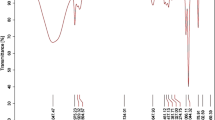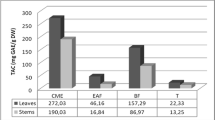Abstract
The antioxidant activity of the crude hydroalcoholic extract (PSMW) and its derived fractions n-hexane (PSH), diethylic ether (PSDE), chloroforme (PSC), ethyl acetate (PSEA), n-butanol (PSB) and residual aqueous fraction (PSA) of aerial part of endemic plant Pituranthos scoparius was performed using three in vitro tests : phosphomolybdate assay, reducing power and DPPH (2,2-diphenyl-1-picrylhydrazyl) radical scavenging capacity. The total yield, total phenolic (TPC), flavonoid (TFC), flavonol (TF) and condensed tannin contents (TCT) of all the fractions were also determined. This plant was also subjected to preliminary phytochemical screening test for various constituents. Phytochemical screening revealed the presence of flavonoids, tannins, coumarins, saponins and steroids in the extracts. Amongst the extracts, PCMW showed the highest TPC (8.40 ± 0.01 mg gallic acid equivalent/g of dry matter), TFC (2.25 ± 0.01 mg catechin equivalent/g), TF (1.19 ± 0.04 mg quercetin equivalent/g) and TCT (1.07 ± 0.16 mg catechin equivalent/g). The Total Antioxidant Capacity (CAT) was found to be varied in different fractions from 0.11 ± 0.00 to 10.02 ± 0.02 mg ascorbic acid equivalent/g). Therefore, PSEA showed the highest antioxidant activities to reduce iron (IC50 = 1.19 ± 0.00 mg/mL) and to scavenge DPPH (IC50 = 0.91 ± 0.02 mg/mL).



Similar content being viewed by others
References
Adida H, Benariba N, Bechiri B, Chekroun E, Djaziri R (2016) Étude phytochimique et évaluation du pouvoir antiradicalaire des extraits de Pituranthos scoparius. Phytothérapie 14(4):207–212.
Arts MJTJ, Dallinga JS, Voss HP, Haenen GRMM, Bast A (2004) A new approach to assess the total antioxidant capacity using the TEAC assay. Food Chem 88:567–570
Benalia H, Djeridane A, Bensafieddine F, Yousfi M (2016) High in vitro antiurolithiatic effect of Pituranthos scoparius roots extracts. PhOL 2016(1):31–43
Bhajoni PS, Meshram GG, Lahkar M, Ghadlinge MS, Rehan HS, Tripathi CD (2015) Evaluation of the role of nitric oxide and antioxidation in the antiulcer activity of Ocimum sanctum leaves: an experimental study. Orient Pharm Exp Med 15(4):313–317
Blokhina O, Virolainen E, Fagerstedt KV (2003) Antioxidant, oxidative damage and oxygen deprivation stress: a review. Ann Bot Lond 91(2):179–194
Bouaziz M, Dhouib A, Loukil S, Boukhris M, Sayadi S (2009) Polyphenols content, antioxidant and antimicrobial activities of extracts of some wild plants collected from the south of Tunisia. Afr J Biotechnol 8(24):7017–7027
Boutaghane N, Nacer A, Kabouche Z, Ait-Kaki B (2004) Comparative antibacterial activities of the essential oils of stems and seeds of Pituranthos scoparius from Algerian septentrional Shara. Chem Nat Compd 40(6):606–607
Butler MS (2004) The roles of natural chemistry in drug discovery. J Nat Prod 67(12):2141–2153
Caunii A, Pribac G, Grozea I, Gaitin D, Samfira I (2012) Design of optimal solvent for extraction of bio–active ingredients from six varieties of Medicago sativa. Chem Cent J 6(1):123–131
Chandra P, Kishore K, Ghosh AK (2015) Evaluation of antacid capacity and antiulcer activity of Calendula officinalis L. in experimental rats. Orient Pharm Exp Med 15(4):277–285
Gilles W (1976) L’encyclopédie des médecines naturelles et des secrets de santé. Elina, Lavoisier, Paris, pp 212–222
Hammiche V, Maiza K (2006) Traditional medicine in central Sahara: pharmacopoeia of Tassili N’ajjer. J Ethnopharmacol 105(3):358–367
Iserin P (2001) Larousse encyclopédie des plantes médicinales. Identification, Préparations, soins, 2nd edn. Dorling Kindersiey Limited, Londres
Julkunen-Titto R (1985) Phenolic constituents in the leaves of northern willows methods for the analysis of certain phenolics. J Agric Food Chem 33(2):213–217
Khan RA, Khan MR, Sahreen S, Ahmed M (2012) Assessment of flavonoids contents and in vitro antioxidant activity of Launaea procumbens. Chem Central J 6(1):43
Khettaf A, Belloula N, Dridi S (2016) Antioxidant activity, phenolic and flavonoid contents of some wild medicinal plants in southeastern Algeria. Afr J Biotechnol 15(13):524–530
Kumaran A, Karunakaran RJ (2007) In vitro antioxidant activities of methanol extracts of five Phyllanthus species from India. LWT Food Sci Technol 40(2):344–352
Kumari A, Kakkar P (2008) Screening of antioxidant potential of selected barks of Indian medicinal plants by multiple in vitro assays. Biomed Environ Sci 21(1):24–29
Mohammadi M, Alaei M, Bajalan I (2016) Phytochemical screening, total phenolic and flavonoid contents and antioxidant activity of Anabasis setifera and Salsola tomentosa extracted with different extraction methods and solvents. Orient Pharm Exp Med 16(1):31–35
Newman DJ, Cragg GM (2016) Natural products as sources of new drugs from 1981 to 2014. J Nat Prod 79(3):629–661
Oyaizu M (1986) Studies on products of browning reaction prepared from glucosamine. Jpn J Nutr 44(6):307–315
Patwardhan B (2005) Ethnopharmacology and drug discovery. J Ethnopharmacol 100(1–2):50–52
Prieto P, Pineda M, Aguilar M (1999) Spectrophotometric quantitation of antioxidant capacity through the formation of a phosphomolybdenum complex: specific application to the determination of vitamin E. Anal Biochem 269(2):337–341
Quézel P, Santa S (1963) Nouvelle flore de l’Algérie et des régions désertiques méridionales. Tome II, Editions du Centre National de la Recherche Scientifique, Paris, p 1170
Sanchez-Moreno C, Larrauri JA, Saura-Calixto F (1998) A procedure to measure the antiradical efficiency of polyphenols. J Sci Food Agric 76(2):270–276
Sharififar F, Dehghn-Nudeh G, Mirtajaldini M (2009) Major flavonoids with antioxidant activity from Teucrium polium L. Food Chem 112(4):885–888
Singleton VL, Rossi JA Jr (1965) Colorimetry of total phenolics with phosphomolybdic- phosphotungstic acid reagents. Am J Enol Vitic 16:144–158
Small E, Catling PM (2000) Les cultures médicinales canadiennes. Presses scientifiques du CNRC, Ottawa (Ontario), Canada, p 281
Tease E, Evans WC (1987) Pharmacognosie, 13th edn. Baillieire Tindall Ltd, London, UK, pp 61–62
Zhishen J, Mengcheng T, Jianming W (1999) The determination of flavonoid contents in mulberry and their scavenging effects on superoxide radicals. Food Chem 64(4):555–559
Acknowledgements
The study was not supported by any source of funding.
Author information
Authors and Affiliations
Corresponding author
Ethics declarations
Ethical statement
N/A.
Conflict of Interest
The authors have declared that no conflict of interest.
Rights and permissions
About this article
Cite this article
Belyagoubi-Benhammou, N., Belyagoubi, L., Bechlaghem, N. et al. Assessment of antioxidant potential and phytochemical analysis of Pituranthos scoparius crude extract and its fractions. Orient Pharm Exp Med 17, 51–57 (2017). https://doi.org/10.1007/s13596-016-0253-7
Received:
Accepted:
Published:
Issue Date:
DOI: https://doi.org/10.1007/s13596-016-0253-7




